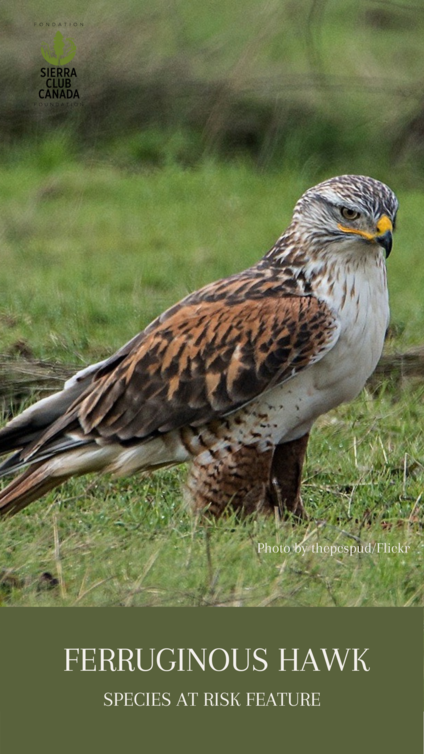
The Ferruginous Hawk (Buteo regalis) is one of the largest North American hawk species, found throughout the southern half of the Canadian Prairie Region. Their habitat consists largely of wide-open prairie and desert land, which makes for prime hunting on their main source of prey - prairie dogs and ground squirrels.
Ranging in size between 56-69cm with a large wingspan of 133-142 cm, the Ferruginous Hawk boasts stunning rufous coloured plumage along its shoulders and speckled throughout its undersides and legs, along with bright white underparts and a grey head. They are often compared to the Golden Eagle for many of their similar features including their large wingspan, and dark plumage.
Ferruginous Hawks are an important avian predator that relies on small mammals such as Richardson’s ground squirrel, prairie dogs, and other ground squirrel species. They are an important factor in regulating species of small mammals throughout the prairies and employ a “sit and wait” technique for hunting.
The Ferruginous Hawk was originally assigned threatened status by COSEWIC in April of 1980. Since then, re-examination and re-designation occurred three more times in April 1995, 2008, and most recently in 2021 with the status Special Concern, Threatened and Special Concern, respectively, for the Prairie region - Alberta, Saskatchewan and Manitoba. With the latest updates on their status only months ago, the Ferruginous Hawk was upgraded to special concern due to the fluctuations in their population numbers due to the impact of human disturbance at nesting sites, and through destruction of the native prairie grasslands, they inhabit.
Historically, Canada’s prairies encompassed 10% of the entire breeding distribution for the Ferruginous Hawk, where due to the destruction of native prairies, only 48% of its historical breeding range is now occupied.
Ferruginous Hawks traditionally occupy land native prairie grasslands, often sharing land with local producers, where small mammals species - such as rodents - are abundant, and provide a significant food source for these large predators. While not threatened by producers directly for their importance in controlling rodent populations, the use of rodenticides on rodent populations poses the risk of secondary poisoning and bioaccumulation of toxins within hawks, in general. Due to the use of rodenticides, traps and other lethal methods for controlling rodent populations, the decrease in rodent populations on the prairies has created significant problems for the Ferruginous Hawk and their ability to sustain their numbers within Canada. In addition to the reduction in native prairie grasslands and the intrusion of land conversion overtaking their habitat, Ferruginous Hawks now occupy a significantly smaller portion of their once large breeding distribution within Canada, being pushed further and further south.
One way that you can help support the increase and restoration of Ferruginous Hawks within their Canadian breeding distribution, is through the condemnation of the use of rodenticides throughout the prairies and encouraging the protection of our remaining native prairies. These methods, while daunting in scale and nature, are vital to the protection of these keystone predators, to ensure their success and survival within Canada.
To learn more about the Ferruginous Hawk, local populations within the Prairies, and ways that you can take action to protect these magnificent birds, follow the links below! :)
Resources:
Ferruginous Hawk Identification, All About Birds, Cornell Lab of Ornithology
Ferruginous Hawk | Audubon Field Guide
Species Profile (Ferruginous Hawk) - Species at Risk Public Registry (canada.ca)
